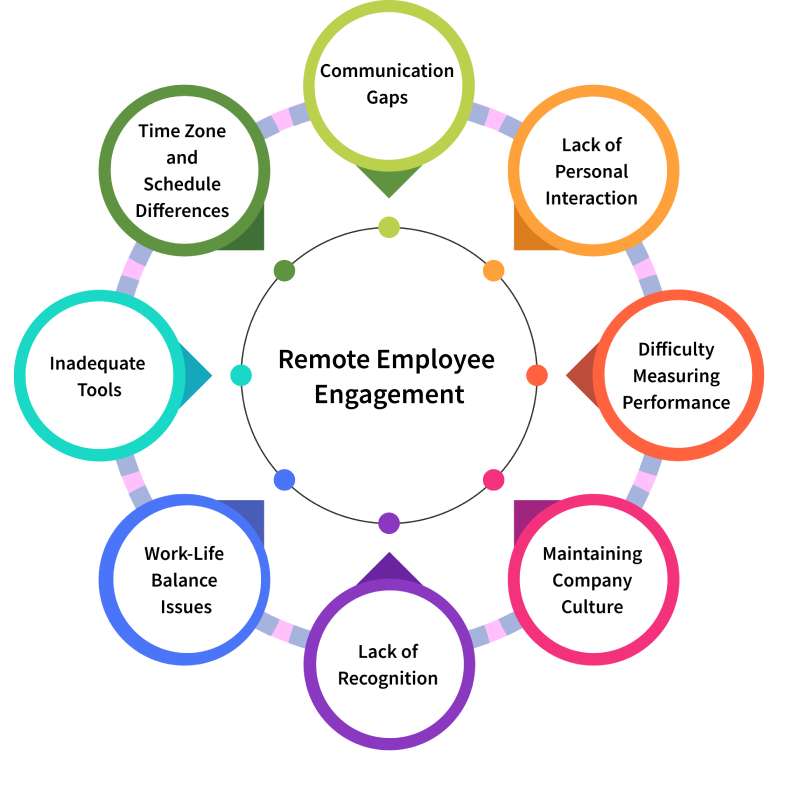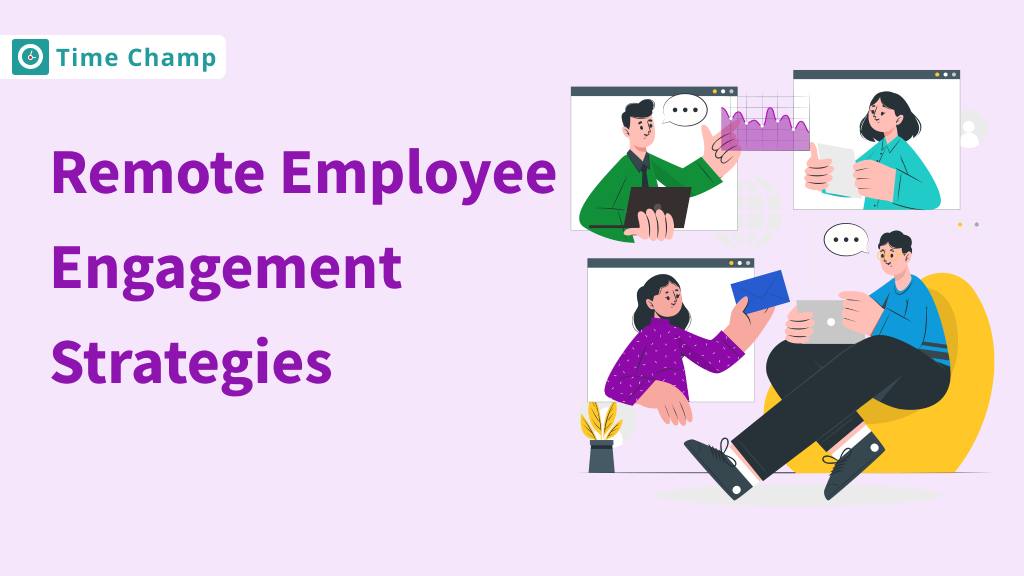Remote work isn’t just a passing trend anymore! it’s here to stay, reshaping how businesses operate and how teams connect. But let’s face it, remote employee engagement isn’t always easy. Without the natural camaraderie of the office, maintaining strong communication, motivation, and team spirit can feel like a challenge. That’s where we come in! In this blog, we’ll cover common challenges in engaging remote employees, the top 10 strategies for remote employee engagement, how to measure engagement, and mistakes to avoid when keeping remote employees engaged.
Whether you’re managing a small remote team or an entire workforce, these strategies will help you foster connection, boost productivity, and keep your employees motivated, no matter where they’re working from. Ready to dive in? Let’s get started and turn remote engagement into your team’s biggest strength!
Why is it Important to Engage Remote Employees?
A PWC study shows that only 8% of employees want to work from their office, which means the remaining employees show little to no interest in working from the office, after the COVID-19 pandemic employees are showing much interest in work-from-home because of the comfort and flexibility it provides.
Do You Know?
Nearly 20% of remote workers feel a sense of disconnection from their peers due to the lack of communication.
When remote workers are not engaged, they may feel isolated and disconnected, which can negatively impact team spirit and collaboration. Therefore,engaging remote employees is a necessity in virtual work environments.
Engaged employees are healthier, more productive, and less likely to experience burnout.
So, as an employer or a manager, it is fully your responsibility to make sure your remote teams stay engaged.
Do You Know?
According to Owl Labs and Global Workplace Analytics report 2022, 62% of employees reported that they are more productive when working remotely, and 52% are willing to accept a small decrease in salary to work from home.
What are the Common Challenges in Remote Employee Engagement

Remote work is flexible for sure but engaging remote employees is not always a piece of cake, it can come with some common challenges.
Communication Gaps
Remote employees often miss out on those little chats and conversations at desks and water cans, which make them feel disconnected from the team and less involved in the day-to-day dynamics of the workplace.
Lack of Personal Interaction
Doesn’t it feel nice to have coworkers who greet you every day, share thoughts and ideas, and even clarify your doubts? Remote workers often feel lonely because they are by themselves at home. The absence of this casual office socialization can impact camaraderie and motivation.
Difficulty Measuring Performance
Even managers struggle to measure productivity without direct observation, which can cause trust problems or constant supervision (known as micro-management). Micromanagement creates stress to perform beyond expectations and results in burnout among employees.
Maintaining Company Culture
Remote employees may not feel like they are part of the company’s culture, and they may not be productive. Cultural relevance is important and should be maintained through virtual events and consistent communication.
Lack of Recognition
Do you ever feel that you’re not getting recognized for the effort you put in? Remote workers often feel less likely to receive recognition, and promotion opportunities seem to remain out of reach for them.
Work-Life Balance Issues
One of the main reasons that cause employee disengagement is the blurring of work and personal life. Most of the time remote employees seem to not draw a line between work time and personal time and end up mixing both leading them to overwork and stress. Companies should promote healthy boundaries to prevent burnout.
Inadequate Tools
Not having access to proper technology is frustrating, isn’t it? Remote employees face the same issues or even more, a sudden power cut during important meetings, and device-related issues cause them to panic during important tasks.
To avoid this many remote companies shall provide their employees with the needed equipment to work without any interruptions.
Time Zone and Schedule Differences
Time zone and schedule differences can make remote work tricky, especially when it comes to collaboration and communication. Employees working from different parts of the world may struggle to find overlapping hours for meetings, feedback, or even casual check-ins. These gaps can lead to delays in decision-making and a sense of isolation, making it hard to maintain team unity.
To keep remote employees engaged, you need to use specific strategies that tackle these challenges and help them stay motivated and connected.
Top 9 Strategies for Remote Employee Engagement
Tackle the remote employee engagement challenges with our 9 best strategies.
1. Stay Connected Using Technology (Videos and Chats)
Connect with your remote employees regularly, and try clarifying their doubts and queries. There are many communication tools you can use like Microsoft Teams, Slack, Zoom, and more.
Regularly engaging does not mean connecting daily on unnecessarily long calls.
Have you heard of the term ‘Zoom Fatigue’? Long, frequent meetings can cause it.
To cut down on Zoom meetings, send instant company updates directly to employees’ phones via an app. You can send these announcements via Teams and Slack by creating channels and tagging everyone. Short, key messages keep the remote informed without wasting time.
2. Encourage Social Interaction & Host Virtual Team Building Activities
Remote workers have fewer opportunities to interact with each other, this can be your opportunity to host some events that are not related to work.
Encourage your employees to socially interact so they can overcome loneliness and engage more effectively. You can conduct interaction sessions or create virtual social events to foster a sense of community and connection.
Here’s our little list of virtual team–building activities:
- Virtual Bingo Night – Have some fun
- Cocktail-Making Class – Try something new
- Virtual Concert – Sing your heart out or enjoy live performances from your team.
- Biweekly Trivia Game – Put your knowledge to the test.
- Virtual Painting Class (paint and sip) – Blend colours and conversations over a drink.
- Virtual Dance-Off Challenge – Show off your best moves
- Virtual Pet Show-and-Tell – Let your furry friends steal the spotlight
- Two Truths and a Lie – Trick your teammates and uncover the truth
- Name That Tune (music guessing game) – Test your music knowledge and guess the hits
- Cooking Challenge or Bake-Off – Whip up something delicious and compete for the tastiest creation
Find more icebreaker games here: 100 Exciting Icebreaker Games for Your Team
Our fun activities list that you can try: Fun Activities for Employee Engagement at Remote Workplaces
3. Show Employees that You Care
Make sure your employees know that you care for them and are willing to listen to them. Ask how they are doing, appreciate them, and offer support for them to better balance work and personal responsibilities.
It is always important to make remote employees feel valued and respected, and you can do this by sending them messages, care packages, or even small gifts.
4. Ask for and Listen to Feedback
Promote communication with your remote workers by asking for their feedback often. It is important to engage them in surveys or one-on-one meetings to hear from them their experiences, difficulties, and ideas.
Simply asking for feedback is not enough, you need to act on it to really make a difference. Responding to feedback addresses employee issues and makes them feel that their voices are heard. This shows that your company is willing to make changes and that you actually care about their opinion.
5. Recognize Employee Contributions & Reward Top Performers
Participating in games isn’t motivating, but winning rewards is. We all have participated in several games competing for the prize, right? In work as well humans crave recognition and appreciation from their superiors to excel further.
According to Deloitte, an employee recognition program can increase employee performance, productivity, and engagement by 14%.
Implement a formal recognition program to celebrate milestones, exceptional performance, or team successes and reward the top performers to boost their motivation.
Some reward ideas:
- Gift cards with their names and a little note
- Reward with extra vacation days
- Offer gym memberships and yoga classes
- Organize award programs
- Show Appreciation through public praise and shout-outs
- Plan team outings
- Send customized gifts
6. Keep Your Employees Informed about Happenings
In the office, employees get to know about all the happenings through their co-workers, meetings, or in-office announcements, but it’s not the same case for remote employees.
Most of the time your remote employees are completely clueless about the happenings and updates of the company.
Ensure that remote employees stay in the loop regarding company news, updates, and changes. Regularly share newsletters, announcements, or updates through email or the company intranet. Keeping employees informed helps them feel connected to the organization’s goals and fosters a sense of belonging and transparency.
7. Support Your New Hires
Provide a seamless and structured onboarding experience for your new remote employees to help them join the team smoothly. This typically includes virtual introductions, training sessions, and assigning a mentor or a buddy to help them as they progress further. Continuous support and regular check-ins during their initial period help your new hires feel welcomed and quickly become productive members of the team.
Additionally, offering access to resources such as company handbooks and training materials can empower them to navigate their roles confidently. Create an inclusive environment that fosters team cohesion and enhances overall job satisfaction.
8. Provide the Tools for Success
Equip your remote employees with the necessary tools and technology to perform their roles efficiently. This involves making sure that your employees have access to the right software, a stable internet connection, and proper home office equipment. Providing all the necessary tools to the employees removes performance barriers and also improves employee well-being.
Additionally, fostering a culture of open communication and support can further enhance their productivity and job satisfaction. By investing in their work environment, you demonstrate your commitment to their success and overall happiness.
9. Conduct Employee Engagement Surveys
Conduct remote employee engagement surveys frequently to assess the level of satisfaction and to identify areas for improvement. You can use the surveys to collect data on various aspects of remote work, including communication, support, and work-life balance.
After collecting the data analyze it and make data-driven decisions to implement strategies to enhance engagement and address any related issues.
How to Measure Remote Employee Engagement
How do you know If your employees are engaged or not in order to implement all these strategies?
Well, that’s why employers measure employee engagement to ensure their employees are engaged enough or not.
Use Employee Surveys and Ask for Feedback
Most of the time employees hesitate to directly express what they feel or their concerns due to many reasons, in such cases, you can use surveys and feedback to gather insights on your employee satisfaction, concerns, and suggestions. Anonymous responses promote open communication and help management make the right decisions that boost morale and productivity.
You can also conduct one-on-one meetings with your employees or conduct a 360-degree review from their peers and managers to evaluate employee engagement.
Analyze Productivity and Performance Data
High productivity always indicates better employee engagement, so evaluate your employee productivity and performance metrics regularly to find out the areas that need enhancement. Monitor time, task completion rates, and project milestones and make adjustments if necessary to meet the goals of the organization.
Monitor Employee Retention and Satisfaction
Measuring employee retention and satisfaction allows for the early detection of problems such as dissatisfaction or lack of growth. Addressing these issues in advance enhances the organizational culture and increases the level of employees’ satisfaction.
This proactive approach not only reduces turnover but also fosters a more engaged and motivated workforce. In the long run, it helps create a positive work environment that attracts top talent.
Conduct Exit Interviews
When employees leave the company conduct an interview and ask them about their experience, what motivated them to stay or leave, and any dissatisfaction they felt. This data helps identify patterns in disengagement and possible areas for improvement.
Use the insights to enhance the work environment, address recurring issues, and implement strategies that increaseemployee retention. Regularly revisiting this feedback can also help prevent future turnover and improve overall employee satisfaction.
Common Mistakes to Avoid When Engaging Remote Employees
Take a look at the common mistakes before getting started, because you can perform well if you know what to do and even better when you know what not to do.
1. Micromanagement
Do not micromanage your remote employees, this puts a lot of pressure on them to perform beyond their capabilities and most of the time leads to burnout and even depression.
2. Lack of Clear Expectations
Do not expect your employees to reach the expectations that you have not clearly expressed. Set clear expectations, communicate clearly, and make sure your employees are well aware of their goals and objectives.
3. Neglecting Mental Health Support
Do not neglect employee mental health issues, mental health issues are more serious than you think. According to the World Health Organization, 15% of working-age adults are estimated to have mental health disorders.
Offer support for the employees who seem down or discouraged and try to maintain a healthy working environment.
Conclusion
In conclusion, remote employee engagement is not merely about setting up online platforms, it’s about creating a work environment where employees feel connected and excited to be involved. Make them feel valued for the work they do so that employees feel motivated enough to put their 100% in. Use our top strategies and make sure to know what to do and what to avoid, finally do not forget to measure your employee engagement often and make changes if needed.
Explore our list of fun activities designed to bring your team together and create moments that matter, even from afar.
Take me there!Frequently Asked Questions
Measure engagement regularly, such as quarterly or bi-annually, to stay updated on employee satisfaction and make necessary adjustments to your engagement strategies.
Use diverse communication channels and schedule regular team meetings to keep everyone informed and connected.
Zoom fatigue is caused by the exhaustion from prolonged video calls. By limiting meeting durations and using other communication methods you can avoid it and ensure better remote employee engagement.
Regular feedback helps employees understand their performance, feel valued, and improve their work.
Share newsletters, and email updates, and use the company intranet to keep remote employees up-to-date on news and changes.






